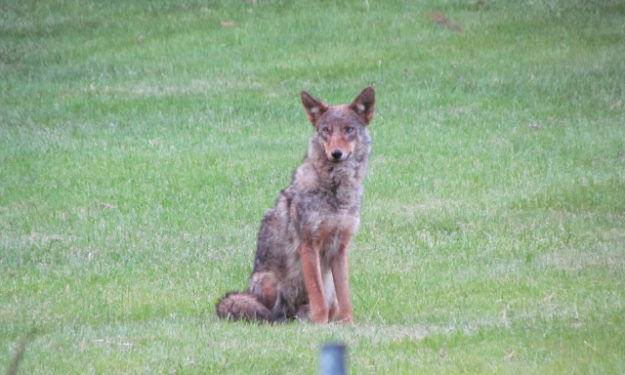Are Coyotes Scared of Humans? Coexisting with Urban Coyotes

Written by Nir Ben-Ari, DVM
Coyotes are becoming an increasingly urban species, earning them the name “urban coyotes.” These are coyotes that reside in metropolitan areas, suburban neighborhoods, and even some urban cities due to the abundance of food and lack of predators. If you live in a rural area, you may sometimes hear strange howling or yipping noises at night coming from a pack. If you’re in the suburbs, you may have seen a coyote quickly cross the road or scamper into a backyard. They are everywhere, and they are here year-round.
The New Age of Coyotes
Coyotes are canines that are found throughout North and Central America and are able to live in an array of ecosystems. They typically live in a pack consisting of a mating pair and up to four more individual coyotes. Coyotes are considered omnivorous, meaning that they eat both animals and plants.
As urban and suburban development has expanded into rural areas, the interaction between humans and coyotes has increased. Coyotes are afraid of people by nature, however this increased interaction has desensitized them. As a result, they have become less fearful of humans and are now starting to be seen more frequently in populated areas. The increased exposure and desensitization has led to an increased frequency of attacks on both humans and pets.
Coyotes are active at night, especially during the hours of dusk and dawn. These seem to be the most common times that coyote attack incidents occur. The typical victim is a small breed dog, but on occasion a large breed dog or even an outdoor cat may be attacked. The locations of the wounds may vary, but the majority of attacks on small breed dogs occur around the neck region.
What can I do to Prevent Attacks?
Here are a few things you can do to prevent your pets from being attacked by a coyote:
- Leash: Always keep your pet on a leash (6 ft or under), especially in areas known to have coyotes.
- Avoid dawn & dusk: Avoid letting your pet out in the yard during dawn or dusk unsupervised.
- Be loud: If you encounter a coyote in your yard or while walking your dog, make yourself large and loud (yell, wave your arms, flap your jacket, carry an air horn). Never turn your back or bend down to pick up your pet.
- Fencing/enclosure: “Coyote-proof” fences should be at least 8 feet in height and be made from materials coyotes cannot climb. An alternative would be a 6 ft fence with “coyote-rollers ” on top. The fence needs to be buried at least 1 foot underground.
- Eliminate smells: coyotes are attracted to areas by smell so be sure to feed your pets indoors, keep bird feeders out of reach, and trash cans sealed tight.
- Hazing: There are non-contacthazing techniques to scare off coyotes and to “re-sensitize” them to being scared of humans. Guidelines are provided by the Humane Society.
- Coyote vests: Consider a protective coyote-proof vest for your dog.
What can I do if my Pet is Being Attacked by a Coyote?
- Yell or make loud noises
- Wave your arms while approaching the coyote
- Throw objects (small rocks, sticks, etc.) at the coyote
- Spray the coyote with water
What Should I do if my Pet was Attacked by a Coyote?
If your pet was attacked, seek immediate veterinary care through your primary care veterinarian or an emergency hospital. Even if you do not visualize any bite wounds or blood, your pet should be checked. Small puncture wounds may be hard to visualize and clipping your pets fur may be needed to get a better assessment. Depending on the severity of the injuries, typical treatment consists of pain management, antibiotics, cleaning the wounds, and potentially surgery.
We live in an area where we must coexist with coyotes and other wildlife, so always err on the side of caution. Coyotes usually will not approach humans, but if they are ill or desperate they may. If your pet spends time outdoors, always keep an eye on them and keep them close. Our emergency team is here for you and your pet 24/7/365 if you need us, but we hope you won’t!
References:
1. VM Frauenthal, P Bergman, RJ Murtaugh. Retrospective evaluation of coyote attacks in dogs: 154 cases (1997–2012). J Vet Emerg Crit Care 2017;27(3):333–34.
2. A template coyote management & coexistence plan. Prepared by The Humane Society of the United States.